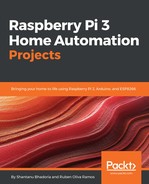Book Description
?With futuristic homes on the rise, learn to control and automate the living space with intriguing IoT projects.?
About This Book
- Build exciting (six) end-to-end home automation projects with Raspberry Pi 3,
- Seamlessly communicate and control your existing devices and build your own home automation system,
- Automate tasks in your home through projects that are reliable and fun
Who This Book Is For
This book is for all those who are excited about building home automation systems with Raspberry Pi 3. It's also for electronic hobbyists and developers with some knowledge of electronics and programming.
What You Will Learn
- Integrate different embedded microcontrollers and development boards like Arduino, ESP8266, Particle Photon and Raspberry Pi 3, creating real life solutions for day to day tasks and home automation
- Create your own magic mirror that lights up with useful information as you walk up to it
- Create a system that intelligently decides when to water your garden and then goes ahead and waters it for you
- Use the Wi-fi enabled Adafruit ESP8266 Huzzah to create your own networked festive display lights
- Create a simple machine learning application and build a parking automation system using Raspberry Pi
- Learn how to work with AWS cloud services and connect your home automation to the cloud
- Learn how to work with Windows IoT in Raspberry Pi 3 and build your own Windows IoT Face Recognition door locking system
In Detail
Raspberry Pi 3 Home Automation Projects addresses the challenge of applying real-world projects to automate your house using Raspberry Pi 3 and Arduino. You will learn how to customize and program the Raspberry Pi 3 and Arduino-based boards in several home automation projects around your house, in order to develop home devices that will really rejuvenate your home.
This book aims to help you integrate different microcontrollers like Arduino, ESP8266 Wi-Fi module, Particle Photon and Raspberry Pi 3 into the real world, taking the best of these boards to develop some exciting home automation projects. You will be able to use these projects in everyday tasks, thus making life easier and comfortable.
We will start with an interesting project creating a Raspberry Pi-Powered smart mirror and move on to Automated Gardening System, which will help you build a simple smart gardening system with plant-sensor devices and Arduino to keep your garden healthy with minimal effort. You will also learn to build projects such as CheerLights into a holiday display, a project to erase parking headaches with OpenCV and Raspberry Pi 3, create Netflix's "The Switch" for the living room and lock down your house like Fort Knox with a Windows IoT face recognition-based door lock system.
By the end of the book, you will be able to build and automate the living space with intriguing IoT projects and bring a new degree of interconnectivity to your world.
Style and approach
End to end home automation projects with Raspberry Pi 3.
